
Go, Baby! These Animal Babies Grow Up Without Any Help From Parents
Why some offspring are left to fend for themselves from day one.
We all need a push once in a while—but hopefully it’s not a literal one.
WAQ reader Hannah wrote in asking, “Do mother birds push their babies out of the nest?”
Daniel Roby, an ornithologist at Oregon State University, says he’s never seen such behavior or documentation of it, though in some bird species, “parents call to their young in the nest to coax them into leaving when it’s time to do so.”
Hannah’s question made us wonder: What brave offspring do get pushed out into the world before they feel they're ready?
Megapodes
Most birds receive parental care (March of the Penguins, anyone?), but megapodes—a group of chicken-like birds native to eastern Australia, New Guinea, Indonesia, and the Philippines—are a big exception.
These birds “do not even directly incubate their eggs,” Roby says. Instead “they build a large mound of decaying vegetation and lay their eggs in the mound.”
According to The Handbook of Bird Biology, the mounds can be “the size of a car.”
The parents do control the mound’s temperature “by removing or adding more vegetation,” says Roby, but once the offspring are born, they dig their way out of the mound and “run off into the brush without ever seeing their parents.”
The chicks can fly within 24 hours.
“Mother crocodiles give their young more post-hatching care than megapodes do,” Roby notes. Indeed, baby crocs are among the very few reptiles that receive parental care, including being carried around in mom’s gigantic mouth. (See video: World’s Deadliest: Killer Croc Carries Babies in Jaws)
Western Fence Lizards
Most lizards, on the other hand, “deposit their eggs, cover them, immediately forget they did that and move along,” says Nassima Bouzid, a PhD candidate at the University of Washington.

Because they have a cloaca, an opening for their reproductive, digestive, and urinary systems, Bouzid says, lizards like the western fence lizards of Yosemite—which she studies—may just think the eggs are “an uncomfortable and weird poop,” and never think about it again.
Bouzid says the lack of parental care in most lizards may simply be part of a strategy to have as many offspring as possible in hopes that some will survive.
Labord’s chameleon
One lizard species goes a step further—not only do the young never see their parents, they never see any adults of their species at all.
At least one population of The Labord’s chameleon of southwest Madagascar’s dry forests “will lay all of their eggs before winter. The eggs will then hatch just before the summer rains,” says Bouzid. The eggs spend eight to nine months developing and in the meantime, the adults will have aged and died.

The newly orphaned offspring “will grow where there are absolutely no adults of their species,” says Bouzid.
“You can imagine if they don’t get a chance to reproduce, the whole population is gone,” Bouzid says of the species, whose forest habitat is threatened by environmental changes.
Butterflies and moths
Many insects receive parental care, but not moths and butterflies. They lay their eggs on host plants and leave their offspring to fend for themselves.
“Some lay their eggs near ant nests and the ants take care of the caterpillars. “It’s like Moses in miniature,” says Katy Prudic, an entomologist at the University of Arizona.
The caterpillar of the large blue butterfly, for example, secretes a sweet substance attractive to a particular species of red ant and makes itself smell like an ant larvae so the ant takes it back to its nest with its own brood, which the caterpillar then eats.
Some young are protected from predators via toxic chemicals from their host plant—and others have pitch-perfect camouflage.
The common lytrosis of eastern North America, for example, is perfectly disguised as a twig. And if it happens to fall off its background branch, it can use its silk to attach a “life line” and pull back up. (Related: Toxic Toupee: Explaining the most Venomous Caterpillar in the U.S.)
Talk about a sticky situation.
Have a question about the weird and wild world? Tweet me or find me on Facebook. Weird Animal Question of the Week answers your questions every Saturday.
Related Topics
You May Also Like
Go Further
Animals
- What La Palma's 'lava tubes' tell us about life on other planetsWhat La Palma's 'lava tubes' tell us about life on other planets
- This fungus turns cicadas into zombies who procreate—then dieThis fungus turns cicadas into zombies who procreate—then die
- How can we protect grizzlies from their biggest threat—trains?How can we protect grizzlies from their biggest threat—trains?
- This ‘saber-toothed’ salmon wasn’t quite what we thoughtThis ‘saber-toothed’ salmon wasn’t quite what we thought
- Why this rhino-zebra friendship makes perfect senseWhy this rhino-zebra friendship makes perfect sense
Environment
- What La Palma's 'lava tubes' tell us about life on other planetsWhat La Palma's 'lava tubes' tell us about life on other planets
- How fungi form ‘fairy rings’ and inspire superstitionsHow fungi form ‘fairy rings’ and inspire superstitions
- Your favorite foods may not taste the same in the future. Here's why.Your favorite foods may not taste the same in the future. Here's why.
- Are the Great Lakes the key to solving America’s emissions conundrum?Are the Great Lakes the key to solving America’s emissions conundrum?
- The world’s historic sites face climate change. Can Petra lead the way?The world’s historic sites face climate change. Can Petra lead the way?
History & Culture
- Hawaii's Lei Day is about so much more than flowersHawaii's Lei Day is about so much more than flowers
- When treasure hunters find artifacts, who gets to keep them?When treasure hunters find artifacts, who gets to keep them?
- Meet the original members of the tortured poets departmentMeet the original members of the tortured poets department
- When America's first ladies brought séances to the White HouseWhen America's first ladies brought séances to the White House
Science
- Should you be concerned about bird flu in your milk?Should you be concerned about bird flu in your milk?
- Here's how astronomers found one of the rarest phenomenons in spaceHere's how astronomers found one of the rarest phenomenons in space
Travel
- Are Italy's 'problem bears' a danger to travellers?Are Italy's 'problem bears' a danger to travellers?
- How to navigate Nantes’ arts and culture scene
- Paid Content
How to navigate Nantes’ arts and culture scene - This striking city is home to some of Spain's most stylish hotelsThis striking city is home to some of Spain's most stylish hotels
- Photo story: a water-borne adventure into fragile AntarcticaPhoto story: a water-borne adventure into fragile Antarctica




